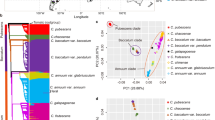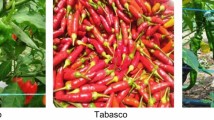Abstract
Pungency or “heat” found in Capsicum fruit results from the biosynthesis and accumulation of alkaloid compounds known as capsaicinoids in the dissepiment, placental tissue adjacent to the seeds. Pepper cultivars differ with respect to their level of pungency because of quantitative and qualitative variation in capsaicinoid content. We analyzed the segregation of three capsaicinoids: capsaicin, dihydrocapsaicin and nordihydrocapsaicin in an inter-specific cross between a mildly pungent Capsicum annuum ‘NuMex RNaky’ and the wild, highly pungent C. frutescens accession BG2814-6. F3 families were analyzed in three trials in California and in Israel and a dense molecular map was constructed comprised mostly of loci defined by simple sequence repeat (SSR) markers. Six QTL controlling capsaicinoid content were detected on three chromosomes. One gene from the capsaicinoid biosynthetic pathway, BCAT, and one random fruit EST, 3A2, co-localized with QTL detected in this study on chromosomes 3 and 4. Because one confounding factor in quantitative determination of capsaicinoid is fruit size, fruit weight measurements were taken in two trials. Two QTL controlling fruit weight were detected, however, they did not co-localize with QTL detected for capsaicinoid content. The major contribution to the phenotypic variation of capsaicinoid content (24–42% of the total variation) was attributed to a digenic interaction between a main-effect QTL, cap7.1, and a marker located on chromosome 2 that did not have a main effect on the trait. A second QTL, cap7.2 is likely to correspond to the QTL, cap, identified in a previous study as having pronounced influence on capsaicinoid content.


Similar content being viewed by others
References
Aluru MR, Mazourek M, Landry LG, Curry J, Jahn M, O’Connell MA (2003) Capsaicinoid biosynthesis: characterization of genes for branched-chain fatty acid biosynthesis. J Exp Bot 54:1655–1664
Ben Chaim A, Paran I, Grube R, Jahn M, van Wijk R, Peleman J (2001) QTL mapping of fruit related traits in pepper (Capsicum annuum). Theor Appl Genet 102:1016–1028
Blum E, Liu K, Mazourek M, Yoo EY, Jahn M, Paran I (2002) Molecular mapping of the C locus for presence of pungency in Capsicum. Genome 45:702–705
Blum E, Mazourek M, O’Connell M, Curry J, Thorup T, Liu K, Jahn M, Paran I (2003) Molecular mapping of capsaicinoid biosynthesis genes and QTL analysis for capsaicinoid content in Capsicum. Theor Appl Genet 108:79–86
Caterina MJ, Schumacher MA, Tominaga M, Rosen TA, Levine JD, Julius D (1997) The capsaicin receptor: a heat-activated ion channel in the pain pathway. Nature 389:816–824
Contreras-Padilla M, Yahia EM (1998) Changes in capsaicinoids during development, maturation, and senescence of chile peppers and relation with peroxidase activity. J Agric Food Chem 46:2075–2079
Curry J, Aluru M, Mendoza M, Nevarez J, Melendrez M, O’Connell MA (1999) Transcripts for possible capsaicinoid biosynthetic genes are differentially accumulated in pungent and non-pungent Capsicum spp. Plant Sci 148:47–57
Deshpande RB (1935) Studies in Indian chillies: 4. Inheritance of pungency in Capsicum annuum L. Indian J Agric Sci 5:513–516
Diaz J, Pomar F, Bernal A, Merino F (2004) Peroxidases and the metabolism of capsaicin in Capsicum annuum L. Phytochem Rev 3:141–157
Estrada B, Diaz J, Merino F, Bernal MA (1999) The effect of seasonal changes on the pungency level of padron I pepper fruit. Capsicum Eggplant Newslett 18:28–31
Estrada B, Bernal MA, Diaz J, Pomar F, Merino F (2000) Fruit development in Capsicum annuum: Changes in capsaicin, lignin, free phenolics, and peroxidase patterns. J Agric Food Chem 48:6234–6239
Govindarajan VS, Rajalakshmi D, Chand N (1987) Capsicum—production, technology, chemistry, and quality. Part IV. Evaluation of quality. CRC Crit Rev Food Sci Nutr 25:185–282
Graham IA, Eastmond PJ (2002) Pathways of straight and branched chain fatty acid catabolism in higher plants. Prog Lipid Res 41:156–181
Grube RC, Zhang Y, Murphy JF, Loaiza-Figueroa F, Lackney VK, Providenti R, Jahn MK (2000). New source of resistance to cucumber mosaic virus in Capsicum frutescens. Plant Disease 84:885–891
Harvell K, Bosland PW (1997) The environment produces a significant effect on pungency of chiles. HortScience 32:1292
Iwai K, Suzuki T, Fujiwake H (1979) Formation and accumulation of pungent principle of hot pepper fruits, capsaicin and its analogues, at different growth stages after flowering. Agric Biol Chem 43:2493–2498
Kim M, Kim S, Kim S, Kim BD (2001) Isolation of cDNA clones differentially accumulated in the placenta of pungent pepper by suppression subtractive hybridization. Mol Cells 11:213–219
Krajewska AM, Powers JJ (1988) Sensory properties of naturally occurring capsaicinoids. J Food Sci 53:902–905
Lee JM, Nahm SH, Kim YM, Kim BD (2004) Characterization nad molecular genetic mapping of microsatellite loci in pepper. Theor Appl Genet 108:619–627
Lefebvre V, Palloix A, Caranta C, Pochard E (1995) Construction of an intra-specific integrated linkage map of pepper using molecular markers and doubled-haploid progenies. Genome 38:112–121
Levin I, Gilboa N, Yeselson E, Shen S, Schaffer AA (2000) Fgr, a major locus that modulates the fructose to glucose ratio in mature tomato fruits. Theor Appl Genet 100:256–262
Liu K, Kang BC, Jiang H, Moore SL, Watkins CB, Setter TL, Jahn MM (2005) A GH3-like gene isolated from Capsicum chinense L. pepper fruit is regulated by auxin and ethylene. Plant Mol Biol 58:447–464
Livingstone KD, Lackney VK, Blauth J, Wijk VR, Jahn MK (1999) Genome mapping in Capsicum and the evolution of genome structure in the Solanaceae. Genetics 152:1183–1202
Maillard MN, Giampaoli1 P, Richard HMJ (1997) Analysis of eleven capsaicinoids by reversed-phase high performance liquid chromatography. Flavour Fragrance J 12:409–413
Nakayama RM, Matta FB (1985) “NuMex R Naky” chile pepper. HortScience 20:961–962
Nelson CJ (1997) QGENE: software for marker-based genomic analysis and breeding. Mol Breed 3:229–235
Panaud O, Chen X, McCouch SR (1996) Development of microsatellite markers and characterization of simple sequence length polymorphism (SSLP) in rice (Oryza sativa L.). Mol Gen Genomics 252:597–607
Paran I, Rouppe van der Voort J, Lefebvre V, Jahn M, Landry L, van Schriek M, Tanyolac B, Caranta C, Ben Chaim A, Livingstone K, Palloix A, Peleman J (2004) An integrated genetic linkage map of pepper (Capsicum spp.). Mol Breed 13:251–261
Rao GU, Ben Chaim A, Borovsky E, Paran I (2003) Mapping of yield related QTLs in pepper in an inter-specific cross of Capsicum annuum and C. frutescens. Theor Appl Genet 106:1457–1466
Reilly CA, Crouch DJ, Yost GS (2001) Quantitative analysis of capsaicinoids in fresh peppers, oleoresin capsicum and pepper spray products. J Forensic Sci 46:502–509
SAS Institute (2000) JMP Users Guide: version 4.0, SAS Institute, Cary
Stewart C Jr, Kang B, Mazourek M, Liu K, Moore SL, Paran I, Jahn MM (2005) The Pun1 gene for pungency in pepper encodes a putative acyltransferase. Plant J 42:675–688
Tewksbury JJ, Nabhan GP (2001) Seed dispersal: directed deterrence by capsaicin in chillies. Nature 412:403–404
Thomson MJ, Tai TH, McClung AM, Lai XH, Hinga ME, Lobos KB, Xu Y, Martinez CP, McCouch SR (2003) Mapping quantitative trait loci for yield, yield components and morphological traits in an advanced backcross population between Oryza rufipogon and the Oryza sativa cultivar Jefferson. Theor Appl Genet 107:479–493
Todd PH Jr, Bensinger MG, Bifty T (1977) Determination of pungency due to Capsicum by gas liquid chromatography. J Food Sci 42:660
Van Ooijen JW, Voorrips VE (2001) JoinMap 3.0, Software for the calculation of genetic linkage maps. Plant Research International, Wageningen, The Netherlands
Vos P, Hogers R. Bleeker M, Reijans M, van der Lee T, Hornes M, Frijters A, Pot J, Peleman J, Kuiper M, Zabeau M (1995) AFLP: a new technique for DNA fingerprinting. Nucleic Acids Res 23:4407–4414
Wang GL, Paterson AH (1994) Assessment of DNA pooling strategies for mapping of QTLs. Theor Appl Genet 88:355–361
Webber H (1911) Preliminary notes on pepper hybrids. Am Breeders Assoc Annu Report 7:188–199
Winkel-Shirley B (2001) Flavonoid biosynthesis. A colorful model for genetics, biochemistry, cell biology, and biotechnology. Plant Physiol 126:485–493
Zewdie Y, Bosland PW (2000a) Capsaicinoid inheritance in an interspecific hybridization of Capsicum annuum x C. chinense. J Am Soc Hort Sci 125:448–453
Zewdie Y, Bosland PW (2000b) Evaluation of genotype, environment, and genotype-by-environment interaction for capsaicinoids in Capsicum annuum L. Euphytica 111:185–190
Acknowledgments
This work was supported in part by U.S.-BARD IS-3225-01C, BARD Postdoctoral Fellowship Award No. FI-327-2002, USDA IFAFS Plant Genome Award No. 2001-52100-11347, NSF Metabolic Biochemistry Award No. 0412056, and NIH Training Grant GM 08500. MM was supported by a fellowship from the Cornell University Graduate School. We thank Kevin Livingstone and Troy Thorup for assistance with the original population development, Kent Welsh and Jon Bava at Gilroy Foods for assistance with the California field trial and HPLC analysis of the 2001 California samples, George Moriarty and Mary Kreitinger for technical and administrative support, Paul Todd, Mary O’Connell and Erik Legg for useful discussions, and gift support from Syngenta, Seminis and Kalsec, Inc. We thank Byung Dong Kim, Istvan Nagy, Umesh Reddy for their willingness to provide data and materials to map SSR loci. We also acknowledge the essential contributions of proprietary SSR markers, data and in-kind support from Syngenta, Seminis, and DNA Landmarks, and AFLP data from Keygene and Sunseeds/Nunhems.
Author information
Authors and Affiliations
Corresponding author
Additional information
Communicated by M. Xu.
Rights and permissions
About this article
Cite this article
Ben-Chaim, A., Borovsky, Y., Falise, M. et al. QTL analysis for capsaicinoid content in Capsicum . Theor Appl Genet 113, 1481–1490 (2006). https://doi.org/10.1007/s00122-006-0395-y
Received:
Accepted:
Published:
Issue Date:
DOI: https://doi.org/10.1007/s00122-006-0395-y




